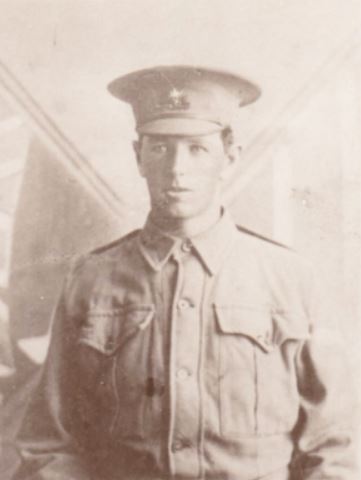Lt
William Robert Booth
Informatie over geboorte
|
Geboortejaar: 1893 |
|
Geboorteplaats: Poowong North, Victoria, Australië |
Algemene Informatie
|
Beroep: Treinbestuurder |
Informatie legerdienst
|
Land: Australië |
|
Strijdmacht: Australian Imperial Force |
|
Rang: Luitenant |
|
Service nummer: / |
|
Dienstneming datum: 08/12/1914 |
|
Dienstneming plaats: Melbourne, Victoria, Australië |
|
Eenheden: — Australian Infantry, 7th Bn. (Laatst gekende eenheid) |
Informatie over overlijden
|
Datum van overlijden: 04/10/1917 |
|
Plaats van overlijden: Molenaarelsthoek, Zonnebeke, België |
|
Doodsoorzaak: Killed in action (K.I.A.) |
|
Leeftijd: 24 |
Gedenkplaats
|
Ypres (Menin Gate) Memorial Paneel: 57 |
Onderscheidingen en medailles 3
|
1914-15 Star Medaille |
|
British War Medal Medaille |
|
Victory Medal Medaille |
Points of interest 3
| #1 | Geboorteplaats | ||
| #2 | Dienstneming plaats | ||
| #3 | Plaats van overlijden (bij benadering) |
Mijn verhaal
William Robert Booth was born in 1893 in the hamlet of North Poowong, Victoria. He was the son Lavinia and Thomas Booth. The family moved to Werribee, west of Melbourne, where his father worked at the post office. William worked as an engine driver, until late 1914, when he enlisted for the Australian Imperial Force in Melbourne. William served with the 7th Battalion, part of the 2nd Brigade, of the 1st Australian Division. In May 1915 he was gravely wounded at Gallipoli, only able to re-join his unit in March 1916. William soon rose in the ranks and in August 1916 he was gazetted as a 2nd Lieutenant and in May 1917 he was promoted to full Lieutenant.
A couple of months later William’s Battalion moved to the frontlines at Passchendaele. Where it took part in the Battle of Broodseinde on 4 of October 1917. It advanced south of the village of Zonnebeke. The 8th Battalion was the first party of the 2nd Australian Brigade to attack. Once they had reached the crest of the ridge the 6th and 7th Battalions would move through to the second objective at Cyclops and Celtic. The 7th Battalion was in position at about 03.30 a.m. At 05.30 the German artillery laid down a heavy barrage on the rear assembly positions, causing heavy casualties. Moments later the 8th Battalion advanced behind a creeping barrage. The 7th Battalion left for the old frontline half an hour later. When crossing the old frontline the 6th and 7th Battalions crowded the left flank. Making them an easy target from machine-gun fire from Retaliation Farm. The German strongpoint had been missed by the 8th Battalion and was eventually taken by the 6th Battalion. In the meanwhile the 8th Battalion had advanced through Romulus and Remus Woods, north of the hamlet of Molenaarelsthoek. They arrived at the first objective, the crest of the Broodseinde Ridge, around 07.15 a.m. At 08.00 a.m. the 7th and 6th Battalions continued the advance. While going up the ridge the 7th Battalion was fired upon from entrenched positions at Celtic Wood and from distant positions on the Keiberg. The Battalion managed to captured the positions at Celtic and started to consolidate a line around 08.40 a.m. No counter-attacks were launched and the Battalion kept on holding the line till they were relieved on the 8th of October.
According to several eyewitnesses Lieutenant William Robert Booth was killed right out by a German shell while the Battalion assembled between Molenaarelsthoek and Zonnebeke.
A couple of months later William’s Battalion moved to the frontlines at Passchendaele. Where it took part in the Battle of Broodseinde on 4 of October 1917. It advanced south of the village of Zonnebeke. The 8th Battalion was the first party of the 2nd Australian Brigade to attack. Once they had reached the crest of the ridge the 6th and 7th Battalions would move through to the second objective at Cyclops and Celtic. The 7th Battalion was in position at about 03.30 a.m. At 05.30 the German artillery laid down a heavy barrage on the rear assembly positions, causing heavy casualties. Moments later the 8th Battalion advanced behind a creeping barrage. The 7th Battalion left for the old frontline half an hour later. When crossing the old frontline the 6th and 7th Battalions crowded the left flank. Making them an easy target from machine-gun fire from Retaliation Farm. The German strongpoint had been missed by the 8th Battalion and was eventually taken by the 6th Battalion. In the meanwhile the 8th Battalion had advanced through Romulus and Remus Woods, north of the hamlet of Molenaarelsthoek. They arrived at the first objective, the crest of the Broodseinde Ridge, around 07.15 a.m. At 08.00 a.m. the 7th and 6th Battalions continued the advance. While going up the ridge the 7th Battalion was fired upon from entrenched positions at Celtic Wood and from distant positions on the Keiberg. The Battalion managed to captured the positions at Celtic and started to consolidate a line around 08.40 a.m. No counter-attacks were launched and the Battalion kept on holding the line till they were relieved on the 8th of October.
According to several eyewitnesses Lieutenant William Robert Booth was killed right out by a German shell while the Battalion assembled between Molenaarelsthoek and Zonnebeke.
Bronnen 6
|
"Passchendaele. The Day-by-Day Account", McCarthy C., London, Uniform, 2018, pg. 110-113. Gebruikte bronnen |
|
AIF-Project https://www.aif.adfa.edu.au Gebruikte bronnen |
|
Australian War Memorial https://www.awm.gov.au/collection/P10265854 Gebruikte bronnen |
|
CWGC https://www.cwgc.org/find-war-dead/casualty/910620/booth,-william-robert/ Gebruikte bronnen |
|
The Long, Long Trail https://www.longlongtrail.co.uk/army/ Gebruikte bronnen |
|
War Diary Australian Infantry, 7th Bn. https://www.awm.gov.au/collection/C1338583 Gebruikte bronnen |
